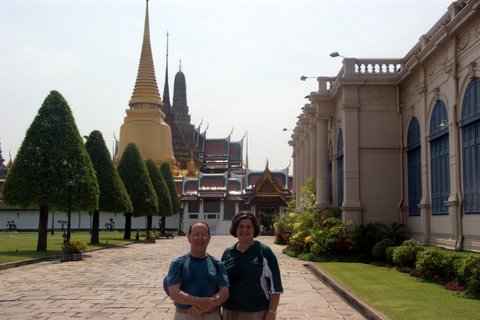Associate Professor of Business Administration Fred Hoyt
Good morning from Bangkok, capital of Thailand and the first stop on our six-country odyssey. I knew we were in the tropics (13 degrees north, over 8,500 direct miles, and around 13,000 frequent flier miles) when I got out of the plane and my glasses fogged up. It was 94 degrees—11 o’clock at night—probably 99 percent humidity—and it will probably be like this through Hong Kong. My colleague, Bill Walsh, describes it as a three showers a day area, but I think that’s true if you can take only three showers a day. If you can take more…you probably do.
I knew it was May 2009 when we got to Tokyo and we had to change planes. That’s always an ordeal at Narita, but it was complicated by the Japanese government’s response to Swine Flu. We sat on the tarmac, filled out forms about where we’d been, etc., put on face masks, and had medical staff with masks come through with a heat gun to take our temperatures before we could evacuate the plane and resume our flight on another aircraft. No problems anywhere else, including at the new Bangkok airport, which is competitive with the great airports of the world.
It’s been five years since I was in Bangkok, but it’s still (despite the heat and partly because everything is either air conditioned or outside) one of my favorite cities to visit. We’ve eased into the rigors of the trip reasonably well partly because the city is so different from anything most of our students are used to, even those from Chicago. It’s at least 10 million people, with the usual juxtapositions of the developing world—shacks beneath skyscrapers, Beemers next to the tuk-tuks (motorbikes with a chariot-like rear that haul 3 people through the city), open markets selling the most wondrous fruits (some you know, like fresh pineapple; some you don’t, like durian, the fruit that “smells like heaven, tastes like hell” and is banned from hotels), restaurants wafting wondrous smells, etc. Since I arrived here for the first time in the mid-1990s, the city has acquired a lot more freeways and built a skytrain, and that’s made the traffic (which includes bright pink cabs), somewhat more tolerable, but like most Asian cities, one must plan on a long trip any time you take a ride.
Our guide says business is way down, and certainly it is for tourism, which is not just one of the world’s biggest businesses, but one of Thailand’s. The combination of the global economy and the political unrest that it’s caused here (plus the political turmoil that closed the airport in December) has scared away tourists.
We’re not able to visit any businesses (for class purposes) because it’s the Buddha’s big day here—birth, death, and enlightenment—a big day especially in a country that is 95 percent Buddhist. Small businesses are open, including the Tony’s Fashion House that I think every tour group gets taken to (and some get taken at) that is one of the many tailors (Thai silk is a specialty). The Buddhism here is quite different from what one sees in East Asia. It’s incredibly colorful, and I’m sure the pictures you’ve seen of Thailand show the Wats (temples), with gold chedis and prangs.
Our day was pretty full, so we didn’t have time to experience jet lag. We left here at 7:30 yesterday morning for a trip to Ayudhya, which was the capital of Thailand from the 14th century until the Burmese leveled it in 1767, and the Thais moved further south (Bangkok itself dates from the early 1770s, when the Chakri family became the rulers and moved from Thonburi, across the river, where they built the Grand Palace, which I’m about to visit later today). My son, David, once described SE Asia as the “Balkans of Europe,” and having been to the Balkans last summer, I can understand what he means—in the sense that the borders shift historically, and the “tribes” have had a history of warfare—the Burmese and the Thais have warred for centuries.
Ayudhya reflects the influence of Buddhism in SE Asia, as all the Wats were built in stone, and their remains are all that are left. When I saw Ayudhya, it was one of the inspirations for me to visit some of the other great ruins (Borobodur in Indonesia, Pagan in Burma, and the most wondrous of all, Angkor in Cambodia), so it was a treat to return—especially with a digital camera, which reduces the 8 rolls of slide film that I used to take to a doable card which enables me to erase mistakes). The chedis and prangs still tower in the sky, the outlines of the rest of the temples still there, with fragments of the destroyed Buddhas (I think I was told that precious stones or relics of the Buddha were in the statues, which is why the Burmese lopped off the heads!)
The highlight was an elephant ride through the ruins. That’s something you don’t get to do at home, and we all took advantage of climbing aboard and imagining lumbering through the jungle from Pagan, Burma (or for the European-minded, over the alps with Hannibal). We took a boat back along the Chao Praya, the river that cuts through Bangkok, which was a nice way to leisurely adjust to being 12 hours time away from you.
You’re about to begin your weekend. We’re about to have breakfast and to be taken someplace spectacular that none of my students have seen before.


